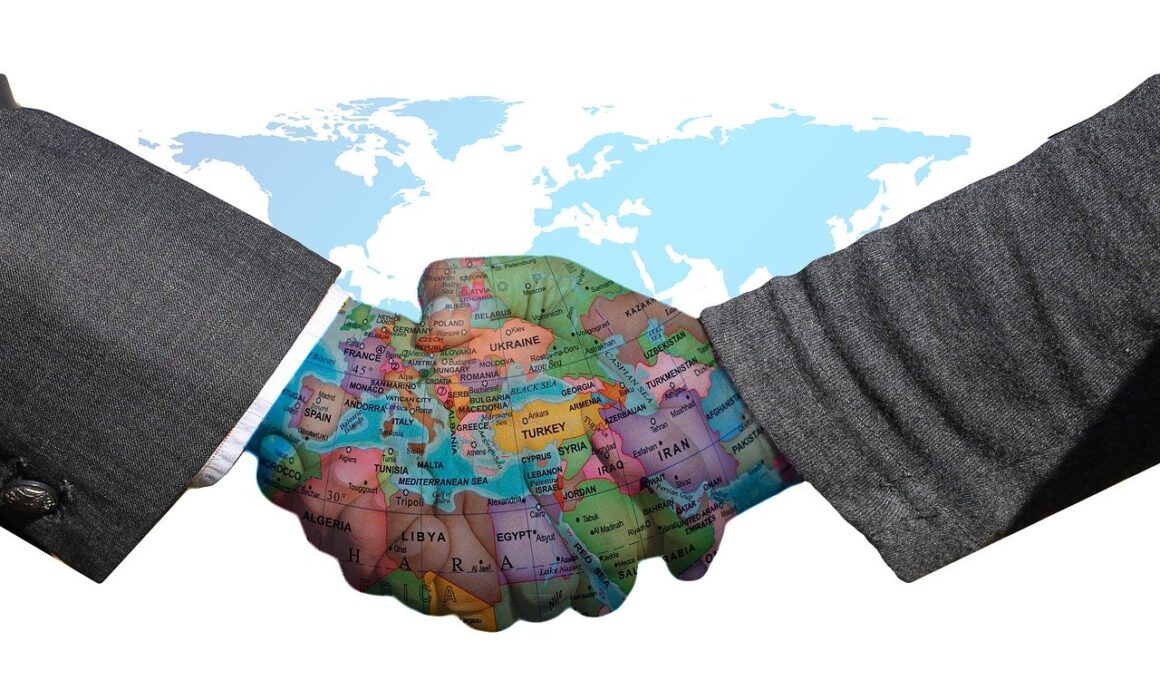The Role of Nonverbal Communication in Cross-Cultural Trade Negotiations
In any cross-cultural context, trade negotiations can significantly benefit from understanding the complexities of nonverbal communication. Nonverbal cues, which range from facial expressions to body movements, play a crucial role in how messages are conveyed and perceived. It is essential for negotiators to recognize these subtleties across different cultures. For example, a gesture in one culture may be seen as positive while in another it might carry a negative connotation. Therefore, research on the importance of these cues is key for international trade. One major aspect is how cultural backgrounds influence perceptions. Individuals engage in trade with assumptions rooted in their cultural experiences. Understanding these differences can aid negotiators in anticipating reactions. Body language, eye contact, and even the use of silence can imply agreement or disagreement. By analyzing these elements, negotiators can create an atmosphere of goodwill. Moreover, effective nonverbal communication can facilitate clarity, reducing misunderstandings. Even something as simple as a smile can flatten barriers. In summary, mastering nonverbal aspects can enhance outcomes in international trade negotiations considerably.
Nonverbal communication incorporates various elements that can bridge gaps in cultural backgrounds. Key components include body language, facial expressions, and spatial distance, all of which vary widely among cultures. Familiarizing oneself with these differences is crucial for successful negotiations. For instance, certain cultures may favor close proximity during discussions, while others prefer more personal space. This distinction can lead to assumptions that affect negotiating power and strategy. Moreover, eye contact is another aspect with divergent interpretations; it can signify attentiveness or aggression, depending on the cultural context. Hence, being attuned to these cues offers insights into underlying sentiments during discussions. Notably, gestures that are commonplace in one culture may be completely foreign or even offensive to another. Thus, taking a proactive approach by researching cultural norms is essential. The use of interpreters is advised when language barriers exist, but even they may miss nonverbal subtleties. Ultimately, a comprehensive understanding of nonverbal communication can bolster the negotiating skills of any professional, allowing them to connect on a deeper level with their counterparts, enhancing the likelihood of mutually beneficial agreements.
Understanding Cultural Differences in Nonverbal Communication
Understanding cultural differences in nonverbal communication is integral when engaging in trade negotiations internationally. Each culture possesses unique ways of expressing attitudes and emotions through nonverbal means. For example, some cultures rely heavily on context and nonverbal cues to convey messages, while others value clarity and direct communication. By recognizing these distinctions, negotiators can avoid misinterpretations. In cultures where silence is valued, a thoughtful pause may indicate agreement, while in cultures favoring frankness; it may raise doubts about willingness to cooperate. This diversity in interpreting silence highlights the need for adaptability. Additionally, nonverbal communication also encapsulates timing in gestures and speech. Certain cultures may expect longer pauses in conversation, reflecting deeper contemplation, while others might perceive them as uncomfortable. Furthermore, the interpretation of emotional displays varies significantly as well. Cultures that emphasize expressive demeanor may view restraint as a lack of enthusiasm. Therefore, adjusting one’s style of communication to meet these cultural expectations can help foster a positive negotiating environment, ultimately enhancing trade relations between countries. By prioritizing this understanding, both parties can better navigate complex negotiations successfully and achieve shared goals.
Nonverbal communication serves as a powerful tool for building trust and rapport in cross-cultural trade negotiations. Establishing a sense of connection is essential for success, particularly across diverse cultural backgrounds. Trust can often be cultivated through consistent nonverbal signals such as open body posture, appropriate facial expressions, and gestures that demonstrate engagement. Maintaining eye contact, where culturally acceptable, signals interest and attentiveness, reinforcing trustworthiness. Conversely, crossing arms or excessive fidgeting may convey defensiveness, potentially eroding trust. Negotiators must be conscious of their own nonverbal cues and their counterparts. This awareness helps in creating a balanced atmosphere conducive to dialogue. For instance, a nod can affirm understanding, while a smile may communicate genuine interest in fostering a relationship. Moreover, the ability to mirror a counterpart’s nonverbal signals can establish rapport and create harmony within the negotiating space. However, mirroring must be done authentically to avoid perceptions of insincerity. Ultimately, by leveraging nonverbal communication effectively, negotiators can enhance trust, solidifying their positions and leading to mutually beneficial outcomes. Trust becomes a key determinant of success in establishing long-term trade partnerships.
Adapting Communication Strategies
Adapting communication strategies based on cultural contexts is pivotal for successful cross-cultural negotiations. It involves more than just verbal language; nonverbal cues must also be integrated into communication frameworks. Different cultures have varying interpretations of body language, tone, and gestures, which can influence perceptions and outcomes. Negotiators should conduct thorough research on the cultural backgrounds of their counterparts, identifying preferences for communication styles and etiquette. For example, while some cultures may prize assertiveness and directness, others may find such approaches abrasive. By adapting to the expected norms, negotiators can foster a more collaborative spirit. Reframing one’s nonverbal behavior to reflect openness and receptiveness can set a positive tone right from the start. Additionally, using pauses effectively in conversation can signify careful deliberation or openness to feedback, which can further enhance communication. Visual aids may also facilitate understanding, bridging gaps caused by language barriers. Thus, strategic adaptations not only enhance communication but also create a respectful negotiating atmosphere. Therefore, recognizing and respecting cultural nuances in communication helps create a smoother negotiation process, increasing opportunities for successful agreements.
Managing misunderstandings caused by nonverbal cues is crucial in cross-cultural trade negotiations. Due to differing interpretations of nonverbal communication, misunderstandings often arise, potentially jeopardizing negotiation outcomes. It is essential for negotiators to be proactive in addressing these discrepancies. First, open dialogue can clarify intentions and expectations, enabling both parties to express their viewpoints without hesitation. For instance, if a gesture is misconstrued, discussing it can alleviate tension and foster mutual understanding. Furthermore, employing a mediator can assist in deciphering nonverbal cues accurately. This strategy is particularly useful when dealing with complex cultural dynamics that may confuse negotiators. Training and workshops focused on cross-cultural communication can also prepare negotiators to handle situations where misunderstandings might occur. Moreover, maintaining flexibility and patience when interpreting nonverbal signals can lead to successfully navigating potential conflicts. Effective coping mechanisms may include seeking feedback and encouraging participants to articulate concerns. By being proactive, negotiators can mitigate misunderstandings and enhance collaboration, paving the way for reaching collective agreements. In the increasingly interconnected world of international trade, managing these subtle nonverbal cues is a skill that can make a substantial difference.
Conclusion: The Importance of Nonverbal Communication
In conclusion, nonverbal communication plays a vital role in cross-cultural trade negotiations. Understanding and mastering these nonverbal cues can significantly enhance the effectiveness of communication and negotiation outcomes. Each culture views expressions, gestures, and interactions through its unique lens, influencing how messages are interpreted. By familiarizing oneself with these differences, negotiators can generate improved dialogue and minimize misunderstandings. Furthermore, the ability to adapt one’s nonverbal behavior and communication style is essential in establishing trust and rapport, two critical components in successful negotiations. Investing time in learning about cultural nuances, exploring nonverbal communication elements, and reflecting on one’s own expressions can lead to forging robust international relationships. This practice will not only benefit trade negotiations but also contribute to long-lasting partnerships built on mutual respect. In today’s globalized economy, the capacity to navigate between diverse cultural landscapes is a valuable asset. Ultimately, when negotiators leverage the power of nonverbal communication strategically, they increase their chances of achieving mutually favorable outcomes, laying the groundwork for prosperous international business endeavors moving forward.
For further exploration, various resources provide insights into the implications of nonverbal communication within international trade contexts. These range from academic articles to practical case studies emphasizing successful negotiation strategies. Books and workshops can also enhance your knowledge, equipping you with concrete skills. By delving into the topic of nonverbal communication in trade negotiations, professionals can foster better relationships and enhance their negotiation skills. Tools such as online courses and seminars bring expeditious benefits. Moreover, seeking advice from experienced negotiators who have navigated similar scenarios adds invaluable understanding. Engaging with intercultural communication experts often leads to broader perspectives on the subject. Many organizations offer training sessions focused exclusively on developing nonverbal communication strengths. Understanding these dynamics within cultural negotiations is no longer optional but a prerequisite for success in a rapidly globalizing market. Utilizing available resources to refine your nonverbal skills may ultimately prove to be a game-changer in trade negotiations. With the right preparation, adaptability, and awareness, seasoned negotiators can position themselves advantageously in their international trade endeavors, ensuring productive and meaningful exchanges. Effective nonverbal communication can transform negotiations, promoting long-term international partnerships.


